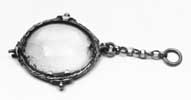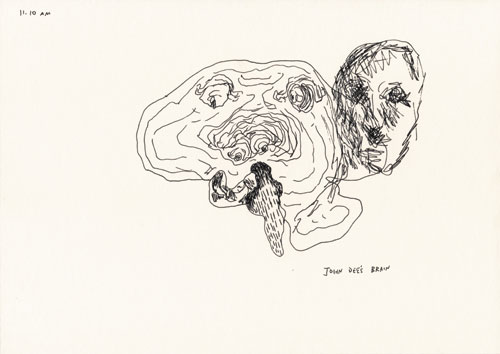|
DR JOHN DEE
|
DR JOHN DEE (1527-1608/9) Alchemist, mathematician, astrologer, kabbalist, occultist and magician. Active in British military and diplomatic affairs. John Dee was 'Queen's Intelligencier' to Queen Elizabeth 1 and a close associate of Sir Francis Walsingham, founder of the British Secret Service. In 1582 Dee's crystal, through contact with angelic spheres, revealed the keys to the Enochian language. The angel instructed Dee and his friend Edward Kelly to point to specific letters which when reversed backwards and forwards revealed messages. The crystal was used to fortell events of a political and military nature, for example regarding the fate of the British Empire and the Spanish Armada. Dee's practice of military/political scrying for Walsingham and Queen Elizabeth 1 is a precursor to the 1972-1995 US Military remote viewing program. The Enochian language was later studied by Aleister Crowley and US rocket scientist Jack Parsons of the O.T.O. In 1994 the Enochian letters were used as glyphs to operate the arc angle in the MGM film 'Stargate' one year before the US remote viewing program, 'Stargate', was made public. A series of remote viewing drawings were made in the presence of Dr John Dee's scrying crystal at the Science Museum, London and experiments were made using Dee's Aztek/Obsidian mirror at the British Museum. |
|
Room
1 / 6, Enlightenment: |
|
Dr
John Dee (1527-1608/9) Mathematician, astrologer and occultist John Dee was a much respected scientist in his own time, but subsequently derided as a conjurer and a trickster. He conceived the universe as being based on essentially magical principles, though believed that many of its rules and laws could be approached through mathematics. After studying at St John's College, Cambridge, Dee travelled to Continental Europe, enrolling in the University of Louvain in 1548. He returned to England in 1551, bringing with him mathematical and scientific instruments of a quality never before seen in the country. He was soon accepted in influential circles around Edward VI and settled down to a life of study. Under Mary I (reigned 1552-58), Dee seems to have lost popularity, and in 1555 he was briefly imprisoned, accused of using enchantments against the Queen's life. He was reinstated after the accession of Elizabeth in 1558, but he never achieved a position that would give him financial independence. However, he was entrusted with the evaluation of the new Gregorian Calendar proposal in 1583, the introduction of which was subsequently rejected in England. During the next quarter century, Dee lived most of the time at Mortlake, publishing two important texts, Monas Hieroglyphica (1564), an abstruse magical treatise, and the Mathematicall Praeface (1570) to Henry Billingsley's translation of Euclid. The Praeface is an eloquent defence of mathematics as the basis for practical work, and greatly stimulated interest in mechanics and scientific instruments. In 1582, Dee came into contact with Edward Kelly (1555?-97), who soon began to act as his medium, and join him in occult research, seeking contact with Divine Spirits. In 1583, Dee and Kelley visited Cracow and Prague, where Dee was made a doctor of medicine at the University. In 1586, for unclear reasons, Dee was banished from the Empire, but was given sanctuary at a castle in Bohemia. He returned to England in 1589, and was made Warden of Christ's College, Manchester. He continued his occult research, but published no more. He died in 1608 or 1609. Dee's Objects in the British Museum: After his death, some of Dee's manuscripts passed into the hands of the antiquary Sir Robert Cotton (1571-1631), whose collection was one of the founding collections that formed the British Museum in 1753. The two smaller wax discs are all that survive of the original four which are recorded in the Cotton manuscripts (now in the British Library) as having supported the legs of Dee's 'table of practice'. The larger one, the 'Seal of God' (Sigillum Dei) corresponds exactly with a drawing in Dee's manuscripts. It was used to support one of Dee's 'shew-stones', the polished translucent or reflective objects which he used as tools for his occult research. All three wax discs are engraved with magical names, symbols and signs. Annotations in the margins of the Cotton manuscript seem to indicate that one of Dee's stones was spherical, thus it has been thought that this sphere may be the 'Chrystallum' in which Edward Kelly, Dee's medium, saw his 'visions'. However, the Cotton provenance cannot be proven nor can the object be identified in the manuscript catalogues of Sir Hans Sloane's collection. The gold disc is engraved with the Vision of Four Castles, experienced during one of Dee's 'experiments' at Krakow in 1584." |





